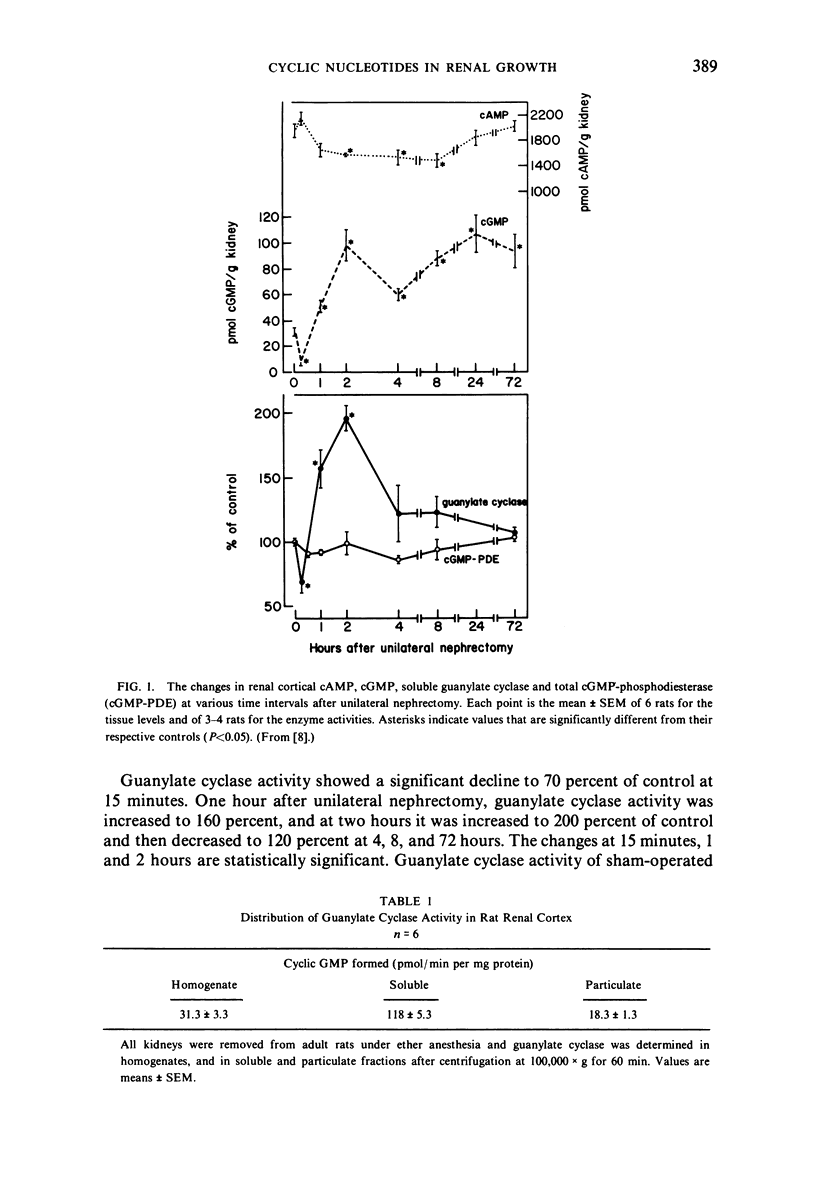Abstract
In adult male Sprague-Dawley rats contralateral nephrectomy was followed by an initial fall of the concentration of cGMP in renal cortical tissue followed by a rise to a peak level of 300 percent of the initial concentration within two hours. cGMP concentration in the remaining renal cortex remained at about 300 percent of the initial value during the subsequent 72 hours and slowly declined to 150-200 percent in the following two weeks. The changes in cGMP concentration were due to exactly parallel changes in the soluble fraction of renal cortical guanylate cyclase activity, while cGMP-phosphodiesterase activity remained unchanged. cAMP concentration after contralateral nephrectomy fell significantly by about 25 percent within two hours and remained below baseline level for up to eight hours. In the kidneys of newborn rats the concentration of cAMP was approximately one-half that found in adult kidneys: it slightly fell between the fourth and the seventh day after birth and subsequently continuously rose to reach adult values approximately two weeks after birth. The concentration of cGMP was significantly greater four days after birth than in adult rats, further rose between the fourth and the seventh day after birth and subsequently gradually declined to adult levels. The increased cGMP concentration appears to be due to an increase of guanylate cyclase activity in total kidney homogenates which, in turn, was mainly due to an increase of the particulate (membrane-bound) fraction of the enzyme. cGMP-phosphodiesterase activity, however, was also increased in respect to adult levels, one or three weeks after birth. Renal growth from the seventh day after birth to adulthood is accompanied by a continuous increase of the ratio cAMP/cGMP. Removal of one kidney four to seven days after birth resulted in a slower increase of this ratio. The data suggest that cGMP may trigger renal growth and that increases of cGMP concentration in the kidneys are the result of a primary increase in the activity of guanylate cyclase.
Full text
PDF





Selected References
These references are in PubMed. This may not be the complete list of references from this article.
- Criss W. E., Murad F., Kimura H. Properties of guanylate cyclase from rat kidney cortex and transplantable kidney tumors. J Cyclic Nucleotide Res. 1976;2(1):11–19. [PubMed] [Google Scholar]
- Goridis C., Reutter W. Plasma membrane-associated increase in guanylate cyclase activity in regenerating rat liver. Nature. 1975 Oct 23;257(5528):698–700. doi: 10.1038/257698a0. [DOI] [PubMed] [Google Scholar]
- Kimura H., Murad F. Evidence for two different forms of guanylate cyclase in rat heart. J Biol Chem. 1974 Nov 10;249(21):6910–6916. [PubMed] [Google Scholar]
- Kimura H., Murad F. Increased particulate and decreased soluble guanylate cyclase activity in regenerating liver, fetal liver, and hepatoma. Proc Natl Acad Sci U S A. 1975 May;72(5):1965–1969. doi: 10.1073/pnas.72.5.1965. [DOI] [PMC free article] [PubMed] [Google Scholar]
- Kuo J. F. Changes in relative levels of guanosine-3':5'-monophosphate-dependent and adenosine-3':5'-monophosphate-dependent protein kinases in lung, heart, and brain of developing guinea pigs. Proc Natl Acad Sci U S A. 1975 Jun;72(6):2256–2259. doi: 10.1073/pnas.72.6.2256. [DOI] [PMC free article] [PubMed] [Google Scholar]
- Rosen O. M. Preparation and properties of a cyclic 3',5'-nucleotide phosphodiesterase isolated from frog erythrocytes. Arch Biochem Biophys. 1970 Apr;137(2):435–441. doi: 10.1016/0003-9861(70)90460-1. [DOI] [PubMed] [Google Scholar]
- Schlondorff D., Weber H. Cyclic nucleotide metabolism in compensatory renal hypertrophy and neonatal kidney growth. Proc Natl Acad Sci U S A. 1976 Feb;73(2):524–528. doi: 10.1073/pnas.73.2.524. [DOI] [PMC free article] [PubMed] [Google Scholar]


